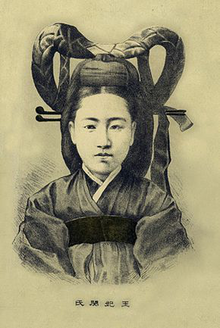
Back ميونغسونغ إمبراطورة كوريا Arabic ميونجسونج امبراطورة كوريا ARZ Myeongseong de Joseon AST Myeongseong de Joseon Catalan Mìng-sìng Huòng-hâiu CDO Myeongseong German Myeongseong de Joseon Spanish امپراتریس میونگسونگ Persian Myeongseong Finnish Myeongseong de Corée French
This article may require cleanup to meet Wikipedia's quality standards. The specific problem is: Needs more references and existing references should be consistently formatted (use Template:Sfn for page numbers). (March 2024) |
| Empress Myeongseong | |||||
|---|---|---|---|---|---|
| Empress Consort of Korea (posthumously) | |||||
 Posthumous drawing of Empress Myeongseong (1898) | |||||
| Queen consort of Joseon | |||||
| Tenure | 20 March 1866 – 1 November 1873 | ||||
| Predecessor | Queen Cheorin | ||||
| Successor | Empress Sunjeong as the Empress of Korea | ||||
| Tenure | 1 July 1894 – 6 July 1895 | ||||
| Predecessor | Herself as the Queen of Joseon | ||||
| Successor | Empress Sunjeong as the Empress of Korea | ||||
| Queen regent of Joseon | |||||
| Tenure | 1 November 1873 – 1 July 1894 | ||||
| Predecessor | |||||
| Successor | None | ||||
| Monarch | Gojong | ||||
| Tenure | 6 July 1895 – 26 September 1895 | ||||
| Predecessor | Regained title | ||||
| Successor | Title and position abolished | ||||
| Monarch | Gojong | ||||
| Born | 17 November 1851 Gamgodang, Seomrak Village, Geundong-myeon, Yeoheung-mok, Kimhwa County, Gyeonggi Province, Kingdom of Joseon[a] | ||||
| Died | 8 October 1895 (aged 43) Okhoru Pavilion, Gonnyeonghap, Gyeongbok Palace, Kingdom of Joseon | ||||
| Burial | |||||
| Spouse | |||||
| Issue |
| ||||
| |||||
| House | Yeoheung Min (by birth) Jeonju Yi (by marriage) | ||||
| Father | Min Chi-rok, Internal Prince Yeoseong | ||||
| Mother | Internal Princess Consort Hanchang of the Hansan Yi clan | ||||
| Religion | Shamanism | ||||
| Seal |  | ||||
| Korean name | |||||
| Hangul | 명성황후 | ||||
| Hanja | 明成皇后 | ||||
| Revised Romanization | Myeongseong Hwanghu | ||||
| McCune–Reischauer | Myŏngsŏng Hwanghu | ||||
| Birth name | |||||
| Hangul | 민자영 | ||||
| Hanja | 閔玆暎 | ||||
| Revised Romanization | Min Ja-yeong | ||||
| McCune–Reischauer | Min Cha-yŏng | ||||

Empress Myeongseong[b] (Korean: 명성황후; 17 November 1851 – 8 October 1895)[c] was the official wife of Gojong, the 26th king of Joseon and the first emperor of the Korean Empire. During her lifetime, she was known by the name Queen Min (Korean: 민비; Hanja: 閔妃). After the founding of the Korean Empire, she was posthumously given the title of Myeongseong, the Great Empress (명성태황후; 明成太皇后).
The later Empress was of aristocratic background and in 1866 was chosen by the de facto Regent Heungseon Daewongun to marry his son, the future King Gojong. Seven years later his daughter-in-law and her Min clan forced him out of office. Daewongun was a conservative Confucian later implicated in unsuccessful rebellion against his daughter-in-law’s faction. He believed in isolation of Joseon from all foreign contact as a means of preserving independence. She, by contrast, was a believer in gradual modernisation using Western and Chinese help. From 1873 to her assassination in 1895 she oversaw economic, military and governmental modernisation.
In the 1880s and 1890s the relationship between Joseon and neighbouring Japan deteriorated. The queen consort was considered an obstacle by the government of Meiji Japan to its overseas expansion.[1] She took a firmer stand against Japanese influence after Daewongun's failed rebellions that were intended to remove her from the political arena.[2] Miura Gorō, Japanese Minister to Korea, backed the faction headed by Daewongun and directly ordered the assassination. On 8 October 1895, the Hullyeondae Regiment loyal to the Daewongun attacked the Gyeongbokgung Palace and overpowered its Royal Guards. The intruders then allowed a group of ronin, specifically recruited for this purpose, to assassinate the queen consort. Her assassination sparked international outrage.[3]
The Japanese-backed cabinet in the winter of 1895–1896 ordered Korean men to cut off their top-knot of hair. This caused uproar, because this style of hair was considered a badge of Korean identity.[4] This topknot edict and the assassination provoked nationwide protests.[5][6] Gojong and the Crown Prince (later Emperor Sunjong of Korea) accepted refuge in the Russian legation in 1896. The anti-Japanese backlash led to the repeal of the Gabo Reform, which had introduced other measures increasing Japanese influence.[5] In October 1897, Gojong returned to Gyeongungung (modern-day Deoksugung). Whilst there, he proclaimed the founding of the Korean Empire[5] and raised the status of his deceased wife to Empress.
Cite error: There are <ref group=lower-alpha> tags or {{efn}} templates on this page, but the references will not show without a {{reflist|group=lower-alpha}} template or {{notelist}} template (see the help page).
- ^ Park, Jong-hyo (박종효) (1 January 2002). "일본인 폭도가 가슴을 세 번 짓밟고 일본도로 난자했다" [Japanese mob tramped down her breast three times and violently stabbed her with a katana]. Sindonga 新東亞. pp. 472–485.
- ^ "Korean Women in Resistance to the Japanese". Archived from the original on 8 March 2002.
- ^ S.C.M. Paine, The Sino-Japanese War of 1894–1895: Perceptions, Power, and Primacy (Cambridge: Cambridge University Press, 2003), p. 316[permanent dead link].
- ^ The top-knot was "the distinctive mark of Korean citizenship": at page 302, The History of Korea Homer B. Hulbert Vol 2 The Methodist Publishing House, Seoul (1905) https://www.gutenberg.org/ebooks/52749 Retrieved 16 September 2023
- ^ a b c 아관파천 (in Korean). Naver/Doosan Encyclopedia.
- ^ Encyclopaedia Korea its land, people and culture of all ages (1960) Hakwon-sa Ltd under Opening of Yi Chosun (1875-1910), After the Sino-Japanese War at page 80-81
© MMXXIII Rich X Search. We shall prevail. All rights reserved. Rich X Search